中西方饮食文化对比-英文版
- 格式:pptx
- 大小:2.49 MB
- 文档页数:10
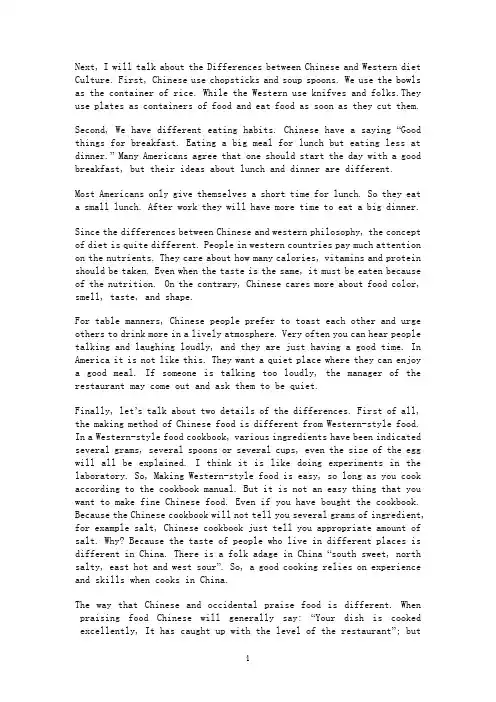
Next, I will talk about the Differences between Chinese and Western diet Culture. First, Chinese use chopsticks and soup spoons. We use the bowls as the container of rice. While the Western use knifves and folks.They use plates as containers of food and eat food as soon as they cut them.Second, We have different eating habits. Chinese have a saying “Good things for breakfast. Eating a big meal for lunch but eating less at dinner.” Many Americans agree that one should start the day with a good breakfast, but their ideas about lunch and dinner are different.Most Americans only give themselves a short time for lunch. So they eat a small lunch. After work they will have more time to eat a big dinner.Since the differences between Chinese and western philosophy, the concept of diet is quite different. People in western countries pay much attention on the nutrients. They care about how many calories, vitamins and protein should be taken. Even when the taste is the same, it must be eaten because of the nutrition.On the contrary, Chinese cares more about food color, smell, taste, and shape.For table manners,Chinese people prefer to toast each other and urge others to drink more in a lively atmosphere. Very often you can hear people talking and laughing loudly, and they are just having a good time. In America it is not like this. They want a quiet place where they can enjoy a good meal. If someone is talking too loudly, the manager of the restaurant may come out and ask them to be quiet.Finally, let’s talk about two details of the differences. First of all, the making method of Chinese food is different from Western-style food. In a Western-style food cookbook, various ingredients have been indicated several grams, several spoons or several cups, even the size of the egg will all be explained. I think it is like doing experiments in the laboratory. So, Making Western-style food is easy, so long as you cook according to the cookbook manual. But it is not an easy thing that you want to make fine Chinese food. Even if you have bought the cookbook. Because the Chinese cookbook will not tell you several grams of ingredient, for example salt, Chinese cookbook just tell you appropriate amount of salt. Why? Because the taste of people who live in different places is different in China. There is a folk adage in China “south sweet, north salty, east hot and west sour”. So, a good cooking relies on experience and skills when cooks in China.The way that Chinese and occidental praise food is different. When praising food Chinese will generally say: “Your dish is cooked excellently, It has caught up with the level of the restaurant”; butoccidental will say it just like what the home make.Then welcome my partner Zhao Bing to tell you the causes of the differences and make a conclusion.欢迎您的下载,资料仅供参考!致力为企业和个人提供合同协议,策划案计划书,学习资料等等打造全网一站式需求。
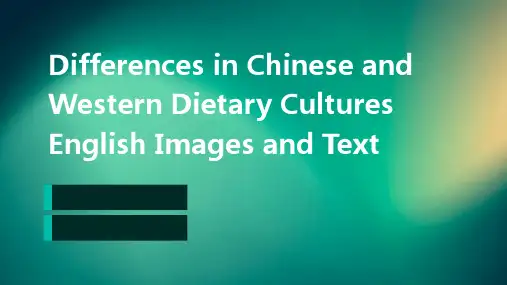
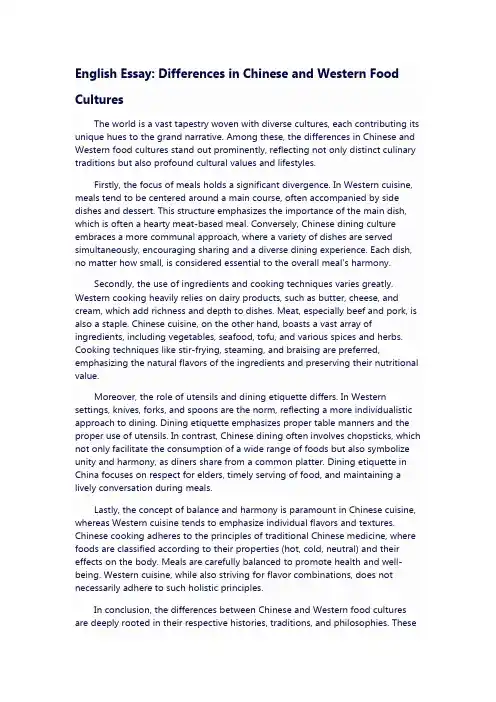
English Essay: Differences in Chinese and Western Food CulturesThe world is a vast tapestry woven with diverse cultures, each contributing its unique hues to the grand narrative. Among these, the differences in Chinese and Western food cultures stand out prominently, reflecting not only distinct culinary traditions but also profound cultural values and lifestyles.Firstly, the focus of meals holds a significant divergence. In Western cuisine, meals tend to be centered around a main course, often accompanied by side dishes and dessert. This structure emphasizes the importance of the main dish, which is often a hearty meat-based meal. Conversely, Chinese dining culture embraces a more communal approach, where a variety of dishes are served simultaneously, encouraging sharing and a diverse dining experience. Each dish, no matter how small, is considered essential to the overall meal's harmony.Secondly, the use of ingredients and cooking techniques varies greatly. Western cooking heavily relies on dairy products, such as butter, cheese, and cream, which add richness and depth to dishes. Meat, especially beef and pork, is also a staple. Chinese cuisine, on the other hand, boasts a vast array of ingredients, including vegetables, seafood, tofu, and various spices and herbs. Cooking techniques like stir-frying, steaming, and braising are preferred, emphasizing the natural flavors of the ingredients and preserving their nutritional value.Moreover, the role of utensils and dining etiquette differs. In Western settings, knives, forks, and spoons are the norm, reflecting a more individualistic approach to dining. Dining etiquette emphasizes proper table manners and the proper use of utensils. In contrast, Chinese dining often involves chopsticks, which not only facilitate the consumption of a wide range of foods but also symbolize unity and harmony, as diners share from a common platter. Dining etiquette in China focuses on respect for elders, timely serving of food, and maintaining a lively conversation during meals.Lastly, the concept of balance and harmony is paramount in Chinese cuisine, whereas Western cuisine tends to emphasize individual flavors and textures. Chinese cooking adheres to the principles of traditional Chinese medicine, where foods are classified according to their properties (hot, cold, neutral) and their effects on the body. Meals are carefully balanced to promote health and well-being. Western cuisine, while also striving for flavor combinations, does not necessarily adhere to such holistic principles.In conclusion, the differences between Chinese and Western food cultures are deeply rooted in their respective histories, traditions, and philosophies. Thesevariations not only enrich our dining experiences but also offer insights into the diverse ways in which cultures around the world approach food, nutrition, and social interaction.中文翻译:中西方饮食文化的差异世界是一幅由多元文化交织而成的壮丽画卷,每种文化都为这幅画卷增添了独特的色彩。
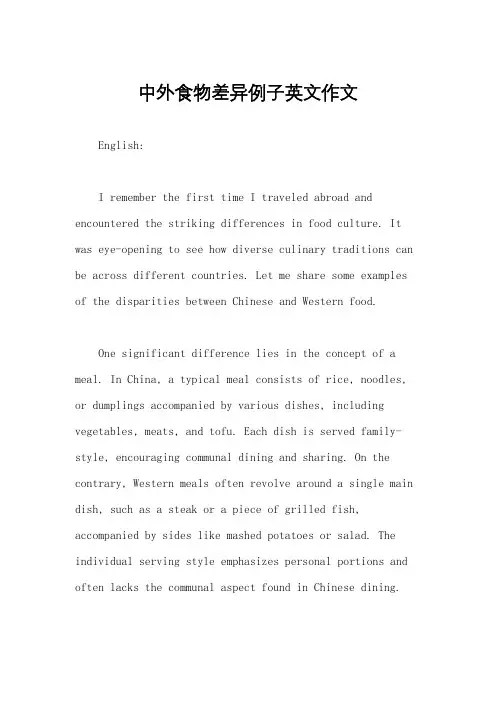
中外食物差异例子英文作文English:I remember the first time I traveled abroad and encountered the striking differences in food culture. It was eye-opening to see how diverse culinary traditions can be across different countries. Let me share some examples of the disparities between Chinese and Western food.One significant difference lies in the concept of a meal. In China, a typical meal consists of rice, noodles, or dumplings accompanied by various dishes, including vegetables, meats, and tofu. Each dish is served family-style, encouraging communal dining and sharing. On the contrary, Western meals often revolve around a single main dish, such as a steak or a piece of grilled fish, accompanied by sides like mashed potatoes or salad. The individual serving style emphasizes personal portions and often lacks the communal aspect found in Chinese dining.Moreover, the use of seasoning and spices differs greatly between the two culinary traditions. Chinese cuisine is renowned for its bold flavors achieved through a myriad of spices like garlic, ginger, chili, and Sichuan peppercorn. These ingredients not only add depth to the taste but also contribute to the holistic balance of flavors. On the other hand, Western cuisine tends to focus on enhancing the natural flavors of ingredients through techniques like roasting, grilling, or braising. While herbs like rosemary, thyme, and basil are commonly used, the intensity of seasoning is generally milder compared to Chinese dishes.Another notable contrast is the role of soup in meals. In Chinese cuisine, soup is considered an essential component of a balanced meal, often consumed at the beginning to warm the stomach and stimulate the appetite. Chinese soups can range from clear broths to hearty stews, featuring a wide array of ingredients such as meats, seafood, vegetables, and herbs. In Western culture, soup is commonly served as a starter or appetizer rather than a main course. It is usually lighter in texture and flavor,meant to whet the appetite rather than satiate hunger.Furthermore, the dining etiquette and customs vary between the two cultures. In China, it's customary to use chopsticks and a soup spoon, with certain rules governing their usage, such as not sticking chopsticks upright inrice or passing food directly from chopsticks to chopsticks. Additionally, showing appreciation for the meal by leavinga small amount of food on the plate is considered polite.In contrast, Western dining etiquette often involves theuse of forks, knives, and spoons, with emphasis placed on table manners such as keeping elbows off the table andusing utensils correctly. Clearing one's plate is generally seen as a sign of enjoyment and satisfaction.Overall, these examples illustrate how food serves not only as sustenance but also as a reflection of cultural values, traditions, and social norms. Exploring the differences in food culture between China and the West has broadened my culinary horizons and deepened my appreciation for the richness of global gastronomy.中文:我记得第一次出国旅行时,我遇到了中外食物文化之间引人注目的差异。
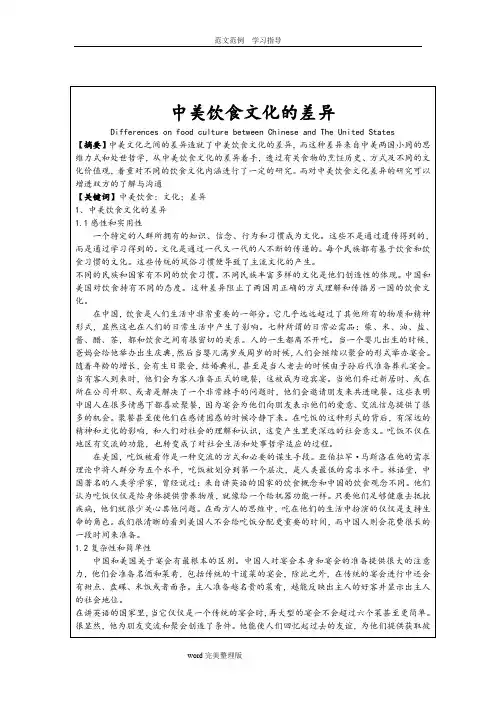
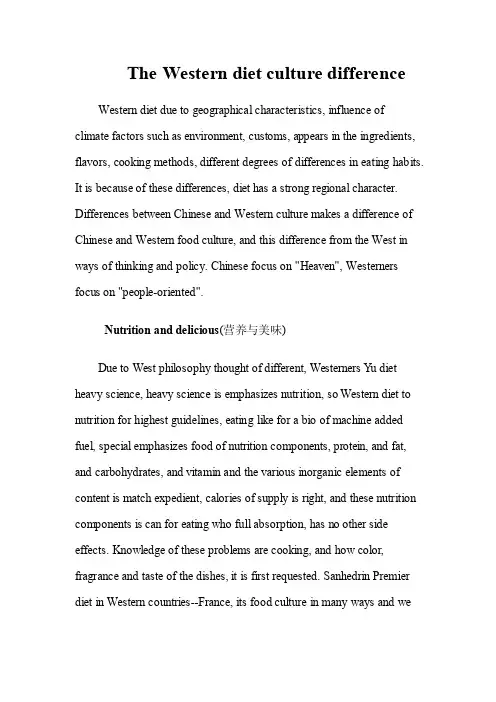
The Western diet culture difference Western diet due to geographical characteristics, influence of climate factors such as environment, customs, appears in the ingredients, flavors, cooking methods, different degrees of differences in eating habits. It is because of these differences, diet has a strong regional character. Differences between Chinese and Western culture makes a difference of Chinese and Western food culture, and this difference from the West in ways of thinking and policy. Chinese focus on "Heaven", Westerners focus on "people-oriented".Nutrition and delicious(营养与美味)Due to West philosophy thought of different, Westerners Y u diet heavy science, heavy science is emphasizes nutrition, so Western diet to nutrition for highest guidelines, eating like for a bio of machine added fuel, special emphasizes food of nutrition components, protein, and fat, and carbohydrates, and vitamin and the various inorganic elements of content is match expedient, calories of supply is right, and these nutrition components is can for eating who full absorption, has no other side effects. Knowledge of these problems are cooking, and how color, fragrance and taste of the dishes, it is first requested. Sanhedrin Premier diet in Western countries--France, its food culture in many ways and weapproximate, but access to nutritional problems, will open the distance between the two sides.Five flavors mixed with the operation aimed at the pursuit of delicious cooking in China, during the processing of the hot frying and slow fire attack for a long time may cause destruction of the nutritional components of food. France is also the pursuit of delicious cooking, but at the same time not forgetting "nutrition" that premise, consistently delicious is that they do not care nutrition for the taking. Especially modern cooking trends occurred in the 1960 of the 20th century, with special emphasis on health, diet, to the pursuit of light oil, emphasized the use of fresh raw materials, stressed during the cooking process to maintain original nutrition and taste, so vegetables are eaten raw. So that the Western diet nutrition is universal。
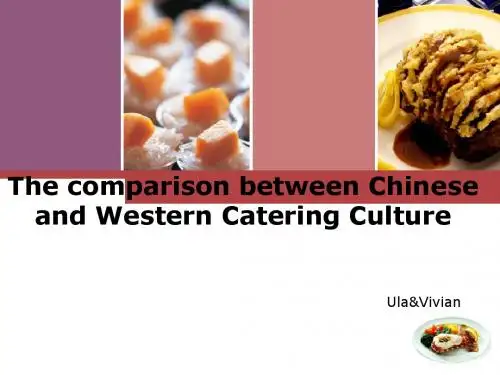

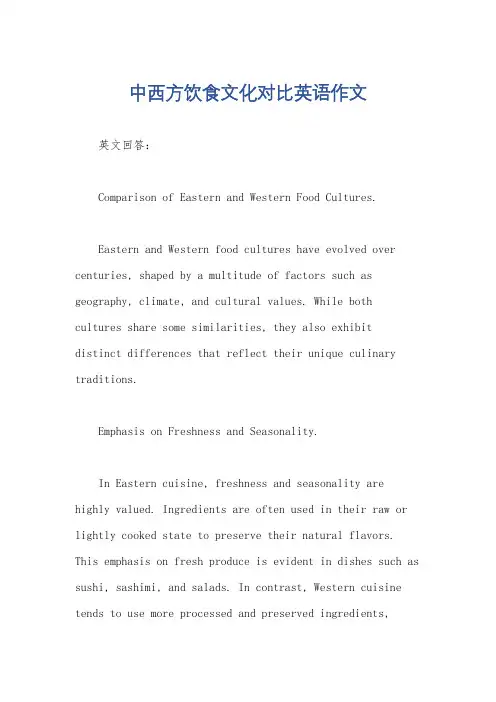
中西方饮食文化对比英语作文英文回答:Comparison of Eastern and Western Food Cultures.Eastern and Western food cultures have evolved over centuries, shaped by a multitude of factors such as geography, climate, and cultural values. While bothcultures share some similarities, they also exhibitdistinct differences that reflect their unique culinary traditions.Emphasis on Freshness and Seasonality.In Eastern cuisine, freshness and seasonality are highly valued. Ingredients are often used in their raw or lightly cooked state to preserve their natural flavors. This emphasis on fresh produce is evident in dishes such as sushi, sashimi, and salads. In contrast, Western cuisine tends to use more processed and preserved ingredients,allowing for greater flexibility in preparation and storage.Balance and Harmony.Eastern cuisine is characterized by a focus on balance and harmony. Dishes often combine a variety of flavors and textures, such as sweet, sour, salty, and bitter. This balance is achieved through the careful selection and combination of ingredients, as well as the use of cooking techniques that preserve the natural flavors of each ingredient. Western cuisine, on the other hand, often emphasizes a single dominant flavor, such as saltiness or sweetness, and may use more intense seasonings and sauces.Communal Dining.In Eastern cultures, dining is often a communal experience, with meals shared among family and friends. Dishes are typically served in large portions and placed in the center of the table, allowing everyone to partake. This communal aspect fosters a sense of togetherness and sharing. Western cuisine, while not always communal, often involvessmaller portion sizes and individual plates, reflecting a more individualized approach to dining.Influence of Religion.Religion has played a significant role in shaping both Eastern and Western food cultures. In the East, Buddhismand Taoism have influenced the development of vegetarianand vegan diets. Hinduism has also introduced a wide rangeof spices and herbs to Indian cuisine. In the West, Christianity has influenced fasting practices and dietary restrictions during Lent and other religious holidays.Availability of Ingredients.The availability of ingredients has also shaped the development of Eastern and Western food cultures. Eastern cuisine has long been influenced by the abundance of rice, vegetables, and seafood in Asia. Western cuisine, on the other hand, has historically relied on wheat, meat, anddairy products, which were more readily available in Europe.Impact of Globalization.Globalization has led to increased interaction and exchange between Eastern and Western food cultures. Ingredients, dishes, and culinary techniques from both cultures have become more widely available and incorporated into new and innovative cuisines. This has contributed to a greater appreciation and understanding of both Eastern and Western culinary traditions.中文回答:东西方饮食文化对比。
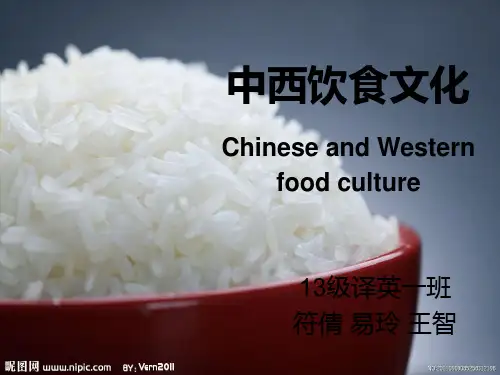
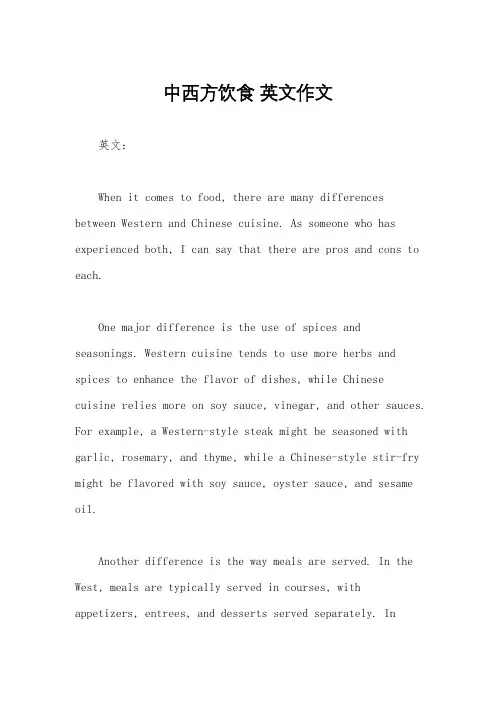
中西方饮食英文作文英文:When it comes to food, there are many differences between Western and Chinese cuisine. As someone who has experienced both, I can say that there are pros and cons to each.One major difference is the use of spices and seasonings. Western cuisine tends to use more herbs and spices to enhance the flavor of dishes, while Chinesecuisine relies more on soy sauce, vinegar, and other sauces. For example, a Western-style steak might be seasoned with garlic, rosemary, and thyme, while a Chinese-style stir-fry might be flavored with soy sauce, oyster sauce, and sesame oil.Another difference is the way meals are served. In the West, meals are typically served in courses, with appetizers, entrees, and desserts served separately. InChina, however, dishes are often served family-style, with multiple dishes placed on the table and everyone helping themselves. This allows for a more communal dining experience and encourages sharing.One thing I appreciate about Western cuisine is the emphasis on fresh, seasonal ingredients. In the summer, for example, you might find a salad made with ripe tomatoes and fresh basil, while in the winter, hearty soups and stews are more common. Chinese cuisine, on the other hand, often features preserved and pickled ingredients, such as pickled vegetables and dried mushrooms. These can add a unique flavor to dishes, but may not be as appealing to everyone.Overall, both Western and Chinese cuisine have their strengths and weaknesses. It's important to keep an open mind and try new things, as you never know what you might enjoy.中文:说到饮食,中西方之间有很多不同之处。
中西方饮食习惯差异英语作文【篇一:中西方饮食文化差异英文版】the western diet culture differencewestern diet due to geographical characteristics, influence of climate factors such as environment, customs, appears in the ingredients, flavors, cooking methods, different degrees of differences in eating habits. it is because of these differences, diet has a strong regional character. differences between chinese and western culture makes a difference of chinese and western food culture, and this difference from the west in ways of thinking and policy. chinese focus on heaven, westerners focus on people-oriented.nutrition and delicious(营养与美味)due to west philosophy thought of different, westerners yu diet heavy science, heavy science is emphasizes nutrition, so western diet to nutrition for highest guidelines, eating like for a bio of machine added fuel, special emphasizes food of nutrition components, protein, and fat, and carbohydrates, and vitamin and the various inorganic elements of content is match expedient, calories of supply is right, and these nutrition components is can for eating who full absorption, has no other side effects. knowledge of these problems are cooking, and how color,fragrance and taste of the dishes, it is first requested. sanhedrin premier diet in western countries--france, its food culture in many ways and weapproximate, but access to nutritional problems, will open the distance between the two sides.five flavors mixed with the operation aimed at the pursuit ofdelicious cooking in china, during the processing of the hot frying and slow fire attack for a long time may cause destruction of the nutritional components of food. france is also the pursuit of delicious cooking, but at the same time not forgetting nutrition that premise, consistently delicious is that they do not care nutrition for the taking. especially modern cooking trends occurred in the 1960 of the 20th century, with special emphasis on health, diet, to the pursuit of light oil,emphasized the use of fresh raw materials, stressed during the cooking process tomaintain original nutrition and taste, so vegetables are eaten raw. so that the western diet nutrition is universal。
中西方饮食文化差异(英文版)Compere:Better compario n , better life.hello every body. Welcome to our .I’m karter. I n our prvious program.w e compared sino-us eco nomic ,price , education, Science and technolog yToday , we will talk abo ut the Differences in Ch inese and American Foo d Culture .First, let’s wa tch a short film about A merican food culture. Okay,the short film is just a bief introducti on. We have the hon or to invite Tom from the United States an d Tony from China.we lcome!For tonday’s topic,w hat’s your opinions?Tom: since the deff irence between Chi nese and western pilosphy,American pay morn attention to scientific diet a nd nutritionTony:well,Chinese t hink a lot of the ta ste.Compere:what abou t the Dining atmos phere ?Tony:Chinese peopl e prefer to Toast e ach other and urge others to drink m ore in a lively atm osphere.Tom:at least ,I do not like it. O n the contrary,we usually eat f ood quietly,even no talking .for drinking we only simbolically t ake a sip.in west banquet ,the host helps the guest to food fo r only once,and then asks the m to eat any more,which is not like the Chinese people’s habi t of urging somebody to drink frequently.it is not allowed to make a noise while eating the food,but the guests should pay attention to appreciate the me als that the owners prepared.if you want to talk with people,yo u can only talk with the ones besides you .we think it is poli te.Compere:ok, one is lively,other is quie t.en,Tom ,do you k now how to use th e Chopsticks? T om:really no .but I tried it ,Ifound it difficult to grasp. I still like my knife and fork Conpere:how to us e them?Tom:in fact,tables a re generally laid wi th one knife and t wo forks,the outsid e fork being for th e salad.Tony:as I know,Americ an eating is funny,they take fork in their left hand,and cut off a pie ce of meat or whateve r it is in the normal m anners.then they put t he knife down,transfer the fork to their right hand,and only then d o they transport the fo od to their mouth.this is every tedious,I think .Compere:is this,Tom? Tom:yes,he said it. Copere:By the way,hav e you eaten breakfast? Tom:ye s,Tony:yes. T ony:don’t your progra m team submit an exp ense account boarding fee?Compere:ok,we will!I want to know w hat did you eat?T o m.Tom: A cup of mil k,An egg and A h amburgerTony;A bowl of no odlesCompere;So it see ms that the food is different,too. Tom:In Western-styl e food cookbook, vari ous ingredients such as the flour, sugar, b utter etc. have been indicated several gra ms, several spoons or several cups, even the size of the egg wi ll all be explained. I think it is like a testi ng laboratory. So, Ma king Western-style foo d is easy, so long as you according to cook book manual。
中外饮食文化差异英文作文Culinary cultures around the world have evolved over centuries, reflecting the unique histories, geographic locations, and societal values of different regions. When it comes to the distinct differences between Chinese and Western cuisines, several key factors stand out. From the fundamental ingredients and cooking methods to the rituals and social norms surrounding mealtimes, the divergent culinary traditions of China and the West offer a fascinating study in cross-cultural comparison.At the most basic level, the primary staple foods in Chinese and Western diets vary considerably. In China, rice and noodles made from grains like wheat and millet form the foundation of most meals. These starchy carbohydrates are typically served as the centerpiece, accompanied by an assortment of vegetable, meat, and seafood dishes. In contrast, the Western diet places greater emphasis on bread, potatoes, and pasta as the main starch components, with meat often occupying the most prominent position on the plate.The differences extend to the types of proteins commonly used aswell. Chinese cuisine makes extensive use of pork, chicken, and an array of seafood, including fish, shrimp, and squid. Beef, though increasingly popular in modern times, has historically played a more secondary role. Western diets, on the other hand, have traditionally relied more heavily on beef, lamb, and poultry, with seafood occupying a less central position.The contrasting dietary preferences are further reflected in the cooking methods employed. Chinese chefs place great importance on the wok, utilizing its high-heat capabilities to quickly sear, steam, and braise a variety of ingredients. Stir-frying, in particular, has become a signature technique that allows for the preservation of fresh flavors and crisp textures. Western cooking, in comparison, tends to favor slower, more deliberate methods like roasting, baking, and grilling, which often result in heartier, more substantial dishes.The seasoning and flavoring of foods also differ markedly between the two culinary traditions. Chinese dishes typically incorporate a complex blend of sauces, spices, and aromatics, such as soy sauce, rice vinegar, ginger, and garlic, to create bold, umami-rich tastes. Western cuisine, on the other hand, often relies on a more limited set of seasonings, such as salt, pepper, herbs, and occasionally butter or cream, to enhance the inherent flavors of the ingredients.Beyond the tangible aspects of ingredients and cooking methods,the social and cultural rituals surrounding mealtimes in China and the West also exhibit distinctive characteristics. In China, shared dishes placed at the center of the table encourage a communal dining experience, where family members and guests engage in lively conversation and the passing of food to one another. This communal style contrasts with the more individualized plate-service common in Western dining, where each person is typically served a single, self-contained portion.The pace and timing of meals also differ significantly. Chinese meals are often seen as an opportunity to savor and enjoy the process of eating, with courses served in a leisurely succession. Mealtimes in the West, in contrast, tend to be more hurried, with the emphasis placed on efficiency and productivity, rather than the pure enjoyment of the culinary experience.These divergent approaches to food and dining are deeply rooted in the cultural histories and societal values of China and the West. In China, the concept of food as a means of nourishing the body, mind, and soul has long been central to traditional philosophies like Daoism and Confucianism. The emphasis on balance, harmony, and the interconnectedness of all things is reflected in the holistic approach to Chinese cuisine.Western culinary traditions, on the other hand, have been moreheavily influenced by the rise of industrialization, urbanization, and the individualistic values of modern society. The focus on efficiency, convenience, and the pursuit of personal gratification has shaped the way Westerners approach food and mealtimes, often prioritizing speed and portion control over the communal, experiential aspects of dining.Despite these longstanding differences, however, the culinary landscapes of China and the West have begun to converge in recent decades, as globalization and cross-cultural exchange have facilitated the sharing of culinary ideas and techniques. Chinese restaurants have become ubiquitous in Western cities, introducing new flavors and dining customs to local populations. Conversely, Western-style fast food and casual dining establishments have gained a significant foothold in urban centers across China, catering to the evolving preferences of a rapidly modernizing society.This cross-pollination of culinary cultures has given rise to a fascinating fusion cuisine, where traditional recipes and cooking methods are adapted and reinvented to appeal to diverse palates. From Americanized Chinese dishes like chop suey and General Tso's chicken to the growing popularity of wood-fired Neapolitan pizza in China, the blending of culinary traditions has resulted in a rich tapestry of gastronomic experiences that defy simple categorization.As the world becomes increasingly interconnected, the exchange of culinary knowledge and the appreciation of diverse food cultures will continue to shape the way we understand and experience the act of eating. While the fundamental differences between Chinese and Western cuisines may persist, the ongoing dialogue between these two distinct culinary traditions promises to yield exciting new culinary innovations and a deeper, more nuanced understanding of the role that food plays in shaping our cultural identities and social experiences.。
C ROSS -CULTURAL C OMMUNICATIONVol. 6, No. 2, 2010, pp. 75-83 ISSN 1712-8358 75The Research of the Differences Between Chineseand Western Diet CulturesUNE RECHERCHE SUR LES DIFFÉRENCES ENTRE LES CULTURES ALIMENTAIRES CHINOISE ET OCCIDENTALEYANG Shi-sheng 1ZHANG Yu-xian 2Abstract: Along with economical development, the diets on people’s dining tables are so diversified that people have free choices. Chinese people are attracted by western diet, and the westerners get fascinated in the Chinese diet too. However, due to the different diet cultures, China and western countries have their own distinct diet cultures respectively, including different diet ideas, diet objects, diet ways, and table manners, etc. Analyzing the differences between Chinese diet cultures and western diet cultures, we can also find the promoting influences on Chinese cultures, and overcome the barriers in cross-cultural communications and avoid unnecessary awkwardness.Key words : Chinese diet culture; western diet culture; differences; cultural rootsRésumé: Avec le développement économique, les aliments sur la table des gens sont si diversifiés que tout le monde ont des choix libres. Les chinois sont attirés par l’alimentation occidentale et les occidentaux sont également fascinés par l’alimentation chinoise. Toutefois, en raison des différences de culture alimentaire, la Chine et les pays occidentaux ont leurs propres cultures d’alimentation distinctes, y compris des idées différentes d’alimentation, des objets de régime alimentaire, des moyens de régime alimentaire et des manières de table etc. Tout en analysant les différences entre les cultures alimentaires chinoise et occidentale, on peut également trouver des influences sur la culture chinoise, surmonter les obstacles dans les communications interculturelles et éviter les maladresses inutiles.Mots-Clés: culture alimentaire chinoise; culture alimentaire occidentale; différences; origine culturelleDiet, like water and air, is regarded as one of the most important things all over the world. We can’t live without diet, so we value the diet so much that people in different regions have formed their own distinctive diet cultures. Along with economical development, people’s living standard is being enhanced day by day. The diets on people’s dining tables are so diversified that people have free choices. 1English Department, Shandong, Jiaotong University, Jinan, China ,250023 2 Office of Student Affairs, Shandong, Jiaotong University, Jinan, China ,250023* Received 14 November 2009; accepted 28 January 2010Chinese people are attracted by western diet, and the Westerners get fascinated in the Chinese diet too. In cross-cultural communications, learning about the differences between Chinese and western diet cultures is very important. It can help us avoid unnecessary awkwardness and overcome the cultural barriers.1. THE INTRODUCTION OF CHINESE AND WESTERNDIET CULTURESWe all know that the diet, as “one of the basic necessities of life”, has the pivotal status in people’s life. The diet culture is actually catching people’s attention, and the diet culture also covers extremely broad research areas, through which we might see the inestimable function of the diet culture to the humanity’s development. Taking a broad view at the world, each region’s big cultural background goes through a long history, and experiences so many changes, then finally forms the present set of cultural system. What is more, it also has the infinite varieties. The diet culture is also not exceptional. There are distinctive differences between Chinese and western diet cultures.1.1 The introduction of Chinese diet cultureThe most thriving enterprise in the world is the restaurant. Among the most prosperous are Chinese restaurants. As the common saying goes, there are three luxuries in one’s life: an American house, a Japanese wife and Chinese diet. Chinese diet is well known for its variety and abundance. According to data on the subject, the number of the well-known ancient and modern Chinese dishes amounts up to 8000.The ingredients may be roughly classified into 600 categories. There are 48 different basic ways of cooking, including roasting, frying and boiling, all of which bring out the best of the ingredients. Besides, Chinese cooking lays emphasis on the three essentials: color, flavor and taste, and thus every dish on the Chinese meal table looks like a piece of art, good-looking and delicious.China is a vast country. Each area has a wealth of local specialties in its cooking. This means that the range of ingredients and cooking styles are incredibly wide and varied. Nevertheless, cooking in China may be grouped into the following four major schools: (1) Northern School. It includes Beijing, Shandong, Tianjin, and Henan cooking, also called “Jing Cai” in Chinese. (2)Sichuan School. (In the upper reaches of the Yangtze) This is the main style in the Sichuan Province, and is called “Chuan Cai” in Chinese. (3)Jiang Zhe School. (In the middle and lower researchers of the Yangtze and also the east coast) This style prevails in Shanghai, Hangzhou, Ningbo and Suzhou, and is also known as the Shanghai School, or “Huai cai” in Chinese. (4) Southern School. This is known as the Canton School or “Yue Cai” in Chinese. It includes Guangdong, Chaozhou and Guangxi cooking.1.2 The introduction of the western diet cultureIn western countries, people also treat the diet as a very important part in their life, especially the nutrition and security of the diet. The imported diet from developing countries must strictly conform to the hygienic standard controlled by the government. Although the western countries’ history can’t be compared with China’s in length, they also have formed their unique diet cultures distinctly different from the oriental diet cultures. In West, the diet cultures are all about the same in spite of small differences existing in very few countries. It means that the ways of cooking, the ingredients, table manners, and even some taboos are more or less the same.Among the different kinds of western-style diets, the French dishes are most famous. They attract thousands of travelers from all over the world to France each year. Generally speaking, the Westerners’ dietary concept is rational. They are particular about the nutrition of their diet very much. What’s more, the western-style diet is usually made in simple ways. They don’t like stewing the diet for a long time, or process it in complicate ways. Because the paces of life are fast in western countries, people prefer to76simplify everything. The appearance of fast diet caters to the need of the westerners. Its convenience complies with the high efficiency of the developed countries.2. THE DIFFERENCES BETWEEN CHINESE ANDWESTERN DIET CULTURESThere are various differences between China and the West dietary habits, but here we mainly discuss their external performances and internal reasons.2.1 The external performances of the differencesThere are perceptual and rational differences between Chinese and western diet cultures. The external performances of the differences include different diet ideas, different diet objects, different ways of having diet, different table manners and so on.2.1.1 Different kinds of diet ideasNobody will deny that the western diet idea is rational, no matter how the diet color, the smell, the taste, or the shape changes, the nutrition of the diet should be guaranteed. Maybe we think that the Westerners are too fastidious about absorbing how much quantity of heat, vitamin, and protein and so on. Even if the taste of the diet is stereotyped, it certainly must be eaten, because it has the nutrition.This diet idea is adapted with the western philosophy system entirely. Metaphysics is the western philosophy’s main feature. The western philosophy studies the principle of the object. The principle of the thing is often the metaphysics principle. The metaphysics principle links up mutually, consequently forming the metaphysical philosophy. This philosophy brings the vitality for the western culture, and causes the prosperity in the natural sciences, the psychology, the methodology, and realizes the development which progresses by leaps and bounds. But in other aspects, this philosophy plays the hindrance role, like the diet culture.At the banquet, the Westerners may be fastidious about the tableware, the needed materials, the service, and particular about the raw material’s shape and color’s matching. But no matter how luxurious and upscale the banquet is, from Los Angeles to New York, the beefsteak only has one kind of flavor. Even if it has matching, that is also carried on the plate.The Chinese diet idea pursues the deliciousness. When people taste the cooked diet, they often say that “it is delicious”, or “that dish is not delicious”. However, if you further ask why it is delicious, and where it is delicious, perhaps it is not easy for us to talk clearly. This indicates that what Chinese pursue in diet is one kind of “the ideal condition” with difficulty to explain, which is usually called “the color, smell and tastes” to make the concept specific by the people. Even in this case, we can’t cover its entire connotation.The reason why the Chinese diet has its unique charm lies in its taste, but the delicacy procedures lie in harmonious proportion, which must make the diet’s own taste, the later taste after heated up, in addition with the tastes of the ingredient and the supplementary material as well as the seasoning harmonized. The tastes are interwoven in the same dish, and they supplement and penetrate mutually, that is to say, in perfect harmony and an ideal condition. The Chinese cooking is fastidious about the beauty of harmony. That is also where the Chinese cooking art’s essence lies. The shape and the color of the dish are the external things, but the taste is actually the intrinsic thing. The Chinese emphasis the intrinsic taste, but not decorates the semblance of the dish desirably. They value the cooked diet’s taste, but not expose the shape and the color of the cooked diet excessively, which is the most important centerpiece of Chinese diet culture.In China, the pursuit of the beauty of the diet prevails over the rationality obviously. This kind of diet77view is also tallied with the Chinese traditional philosophic thinking. As Eastern philosophy’s representative, the Chinese philosophy’s outstanding features are macroscopic, direct-viewing, fuzzy and evasive. The Chinese dish processing method is in harmonious proportion; finally it must turn out to be a pleasant taste. This is fastidious about the discretion and the coordination on the whole. It also contains the rich Chinese philosophy thought. In Chinese cooking method, what has been done should guarantee the taste and harmony of the dish, no matter what has been changed. It even decides the characteristics of the Chinese dish schools and the characteristics of the Chinese chef.2.1.2 The differences of the Chinese and western diet objectEvery diet cannot do without the vegetable. In China, “the vegetable” is a phonogram. It concerns with the plant. According to the western plant scholars’ investigations, there are 600 kinds of vegetables which the Chinese eat. It is more than six times than those in the West. In fact, in the Chinese’s cooked diet, the dish made in vegetables is their daily diet. Only when it is holidays or the living standard is enhanced, the dish which meat is the main ingredient enters the ordinary diet structure. Therefore it has had the say-so of “the vegetable diet” since the ancient times. The vegetable diet occupies the dominant position in Chinese ordinary diet structure. The Chinese take the plant as the main ingredient in the dish. That has countless ties with the Buddhism’s dissemination. In Buddhism, they regard the animal is “the life”, but the plant is not. Therefore, they advocate the vegetarianism.The westerners don’t have such custom probably. They have received the nomadic and the navigational nationalities’ cultures, and have blood relationship with them. So their hunting and fishing were developed, but the cultivation was comparatively backward in ancient times. As a result, they take the vegetables as auxiliary diet, and eat much meat, because they breed many animals. Even the western medicine absorbs the refinement from the animal bodies.When the westerners introduce their diet characteristics, they think that they emphasize more on the nutrition of the diet compared with the Chinese. They have the more developed diet industry, like the canned diet, the fast diet and so on. Although the taste is stereotyped, yet they save plenty of time, and the nutrition is good. Eating more meat and absorbing more protein than Chinese, the westerners are generally more vigorous and healthier than the Chinese: tall height, long legs, broad shoulders and developed muscles. But the Chinese seem to be thin and small: narrow shoulders and short legs. They have light yellow skin and appear not so strong.According to the obviously different characteristics between the Chinese and western diet objects, some people call the Chinese “the plant disposition”, but the westerners “the animal disposition”. The differences are also reflected in the aspect of cultural behavior. The westerners like taking risks, trying new things and experiencing changes. But the Chinese live contentedly in one place with few inclinations to move elsewhere, and they are comparatively stable.2.1.3 The different ways of having dietThe ways of having diet are greatly different between China and the western countries. This kind of difference is also influential to the national disposition. In China, any banquet, no matter what purpose it is out of, has only one form that everybody sits in a circle all round, sharing one table. The banquet must use the round table. This form has created one kind of unity, friendly, interest-sharing atmosphere. The delicacies are placed in the center of the table. The delicious diet is not only the object which people appreciate and taste, but also the media by which people share their feelings and promote sentiments.During the banquet, people propose the toasts mutually, offer the delicious diet and persuade each other to have a taste. The cheering atmosphere manifests the virtues of mutual respect and courtesy. Although viewed from the hygienic angle, this diet way has obvious deficiency, but it conforms to our nationality’s universal point of view “the big reunion”, or in other words, “the happy ending”. It also reflects the Chinese classical philosophy “harmony”, which greatly affects the descendants’ thoughts. It is convenient for collective communications, thus it has difficulty to reform this tradition until now.In western-style banquets, although the diet and the liquor are very important, in fact, they play78auxiliary roles. The core of the banquet lies in building up the friendship. They usually talk with the people who are adjacent their seats to realize this purpose. If we compare the friendship-building function of the banquets to dance, we can say that the Chinese type of banquet is just like a group dance, but the western-style banquet is just like a man and a woman’s social dance. Thus it can be seen that the main purpose of both the Chinese type of banquet and the western-style banquet is to build up friendship. The difference is that the Chinese type of banquets emphasizes the interaction of all the members around the table, but the western-style banquets value the interaction of the neighboring guests.The western buffet is much more different from the traditional Chinese diet way. In the western buffet, all the different kinds of diets are put on the table. Everybody according to his needs takes several kinds of diets on his own plate. What is more, when they are eating, they need not fix on the seats. They can take a walk freely. This way is convenient for people to communicate and exchange ideas with each other. There is no need that all the topics are discussed on the table. It also displays the Westerners’ respect for individuality and ego. But everybody eats respectively and don’t chat mutually, so it lacks the cheering atmosphere on western dining tables.In addition, there are vastly differences in table manners. Some of normal behaviors in one culture are considered taboos in another cultural people, which can cause unnecessary troubles both for you and other people. Given that, if the problem is properly dealt with, it can promote the communication between different cultures.2.2 The internal reasons of the differencesThe differences in social development, traditional cultural ideology, life style result in the differences in Chinese diet culture and western diet culture. Learning about the internal reasons of the differences can help us further understand the differences in diet cultures.2.2.1 The origin of the Chinese dietThe Chinese traditional culture is the major origin of the Chinese diet. The Chinese culture in early stage was constrained by geographical environment. China is situated in the southeast of Asian Continent. The Northwest is limitless desert and grassland; the southeast is the vast ocean. The Chinese cultural breeding ground-the river basin of Huang River has fertile soil, but its climate condition is very bad. The river basin of Huang River gradually became arid and it was not suitable for agricultural production. Although the thinkers in the early Qin dynasty racked their brains to rebuke each other, they reached the same goal by different ways at last. That was to build an ideal world without fight. Chinese culture has another two features: one feature is to pursue practicality. In Chinese history, all the practical science and technology are very developed, such as the agricultural technologies and medicine, which are quite flourishing. On the contrary, the impractical things couldn’t develop. The other feature is that Chinese culture shows distinctive benevolence. The core of Confucianism is to love others, which has far-reaching influence on Chinese traditional cultures.2.2.2 The origins of the western dietThe western culture is the major origin of the western diet. The western culture refers to the cultural system originating in the west hemisphere, which contrasts to oriental culture. The narrow sense of western culture only means the European culture. When this paper refers to the cause and source of western culture, it means the narrow sense of western culture.The childhood of western culture-Greece civilization is the oldest civilization in the world. Her source lies in the northeast of Mediterranean. Due to the unique climate and geographical environment, the distinctive production ways and civilization of Greece take shape. Owing to its source, the Mediterranean couldn’t provide abundant natural living material in the period of ancient Greece, so people there strived to explore the mystery of nature and obtained fortune from nature as much as possible. Therefore, exploiting and utilizing natural resources to serve people become the main stream of79European spirit. The desire of exploiting nature and conquering nature promotes the birth of natural science. In the course of conquering nature and cultivating scientific consciousness, the westerners attached importance to develop rational thinking. Reason gradually becomes the typical feature of western cultures. Reason is to think calmly, analyze and reckon strictly, so that people’s activities can conform to nature law in the course of exploiting nature. When people learn about nature, they are also learning about themselves.Another important feature of western culture is individualism. They are self-centered and lay stress on dignity of personality. People divide their interests strictly. Each person has his own life space, and they don’t interfere with each other. The western culture is influenced by Christianity. It follows the theory of “original crime”, which advocates that approaching benefits and evading harm are the nature of human beings. The doctrine of Christianity advocates that people are born criminal. It seems to conflict with the secular world outlook. In fact, they supplement each other. The former encourages people’s creativity and bold claim on nature. The later restrains people’s behavior. It restricts people to run wild with the punishment of God.3. THE FUTURE TRENDS OF CHINESE AND WESTERNDIET CULTURESAlthough there are so many differences between Chinese and western diet cultures, yet their developments have reflected some common features, from which we can see the future trends of Chinese and western diet cultures. The scientific diet concepts are accepted by people from all over the world, regardless of their cultural backgrounds. Exploring the trends of diet cultures in the future can lead us not only to have better life but also find the common ground to enhance the communication between different cultures.3.1 Survey to the attitudes toward Chinese and western dietAs the development of society, the diet cultures also have taken on some new features. How will the Chinese diet culture develop in the future? How do the present people regard this question? Then conducting a research about Chinese diet will be very essential. We have made a series of investigations in several western dining rooms.A. Do you like the Chinese diet or the western-style diet?Western-style diet 3%; Chinese diet 37%; both 60%.From this we can see, the people who are purely like the western-style diet are few; the people who only prefer the Chinese diet are also few, although larger than former in number. In fact, most people like both of them. Therefore, it means that most people not only have the traditional Chinese diet, but also have some western-style diet. This involves in the question of the fusion of the Chinese diet and the western-style diet.B. What kinds of diet do you like in the western-style diet?The answers mainly are: bread, hamburger, pizza, cold drink, coffee, fries, ice cream, curry, salad, mashed potatoes, and hot dog.Here we only list the examples what some people like in western-style diet. These diets extremely have representative features at the same time. Let’s think it over carefully that these diets, like the hamburger, the hot dog, appear frequently in our life, especially when we have breakfast, make a travel, or camp out of doors, they are necessary. The fries, the ice cream, and some cold drinks are all our good between-meal snacks. The sweets add colors to our life. Moreover, some special western-style pastry shops, like the Pisa shops, the bakeries and so on also increase day by day. They provide the opportunities for the people to taste the western-style diet.80C. What diet do you like in the Chinese diet?The answers mainly are: the rice, the hot pot, the Chinese dumplings, the spring roll and the noodles.We have to admit that the traditional Chinese dishes do not have specific symbolic representatives. Perhaps when it comes to “delicacy”, it is only an abstract concept in Chinese people’s mind. They can’t tell you what delicacy is immediately, because there are so many delicious diets in China. Different people have different definitions of “delicacy”. The daily diet, such as the rice and the noodles can also be defined as the delicacy. For thousands of years, they are always the essential staple diet in China. Some snacks are also extremely attracting, like the spring roll, meat pie, lunar New Year’s cake, glutinous rice cake and so on. The hot pot is another way of Chinese diet. It has regional difference in China. Some people from the north like it very much, especially in the cold winter. It is worth mentioning that there are many famous old shops in Beijing, which have been selling the delicious diets for hundreds of years, such as the Quanjude, Donglaishun, Gundeling, Liubiju and so on.D. Which kind of diet do you think will receive welcome in future?Chinese diet: 70%; Western-style diet: 30%From this we can say that although the western-style diet enters our life quickly, yet the Chinese diet still plays the leading role in our daily life at present and in the future. The Chinese traditional diet habits and customs will not be easily changed.E. Do you think the western-style diet can be better merged?Can: 80%; cannot: 20%It indicates that most people hope that the western-style diet can be fused with the Chinese diet, and they have confidence about it.F. Do you think how the western-style diet will be fused with the Chinese diet?When Chinese eat the western-style diet, we should avoid its high quantity of heat. The western-style diet should be popular among the common people. The Chinese meal should also become facilitated. The staple diet of the western style and the vegetable of Chinese meal should be put together. Make the western-style diet with the Chinese processing procedures. Make the Chinese meal with the western-style diet’s processing procedures.From the survey above, we can see that one trend of the diet cultures in the future is fusion. As the development of the internationalism, the whole world is becoming more and more like a big family. Due to the development of science, the communication facilities are greatly improved. As a result, the communications between different regions, races, nations and religious become more and more frequent, including the cross-culture communication. As an important composing part of cultures, the diet cultures have also taken on some new features. These years, different diet cultures not only carry forward their own advantages, but also take in others’ merits. This makes the diet cultures become more colorful and attracting. It also provides modern people more opportunities to taste countless kinds of delicious diets from all over the world. In the future, both Chinese diet and western-style diet will have some changes. These changes conform to the needs of peoples’ life. They also display the trends of the future diet cultures.3.2 The common trends of the future diet culturesAs the development of the internationalism, the whole world is becoming more and more like a big family. The communications between different regions, races, nations and religious become more and more frequent, including the cross-culture communication. Although there are so many differences between Chinese and western diet cultures, we can find some common trends of the diet cultures in future through their developments.813.2.1 The trend of vegetarianismAs the living standard has been greatly improved, modern people eat more meat, oil, dairy diet, and so on. The calories in the diet we eat every day have exceeded what is needed normally. It leads to the increase of the obese people in our life. Due to the diet structure, the westerners eat more meat than Chinese, so the number of fat people in the developed countries is much larger than that in China. Getting too fat is not good to our health, which can cause various kinds of diseases, such as the heart disease, high blood pressure, and etc. They are all threatening our lives. One important way to prevent these diseases is to control our diet. To keep healthy, we need to eat less greasy diet and eat more vegetables. So the vegetarianism has become one trend of the future diet cultures.In the past, only the monks were vegetarians, because the animals are considered as “the life” in Buddhism. It is forbidden to kill animals in Buddhism. Of course, it is forbidden to eat meat. But in modern society, vegetarianism has become a fad. More and more people are pursuing health, especially the women, who care about their figures very much and always want to keep slim. The vegetarian restaurants spring up everywhere. It is convenient for us to have delicious and healthy vegetable meals. After innovation and reformation, the vegetarian meals have become excellent in the diet colors, cooking methods, and the management of the vegetarian restaurants. In additional to people’s pursuit of health, the number of vegetarians increases dramatically. But we should pay attention that the women who are losing weight need to eat some diet containing vitamins and fat, because eating the vegetarian meals for a long time may cause the imbalance of nutrition. However, for these people who are eager for health, vegetarianism is worth trying.3.2.2 The trend of healthy dietThe broad definition of culture is a kind of customs and habits. Because different people have different customs and habits, which lead to that one culture can’t be accepted by all the people. People can’t accept the cultures which are entirely different from theirs. But generally speaking, the right things which are beneficial to humanity can be accepted by people from different cultures.The healthy diet, as another trend of future diet cultures, is welcomed by people from all over the world. Nowadays, we are not just satisfied with having enough diet, but we are pursuing a much higher standard—the healthy diet. We can buy varieties of meat, vegetables, grains, and non-staple diet in supermarkets and shops, so the ingredients on our dinning tables have become richer and richer. However, some people are particular about their diet. They prefer to eat meat dishes, because they are acrid and strong-smelling. These diets can stimulate our appetite. As a result, people eat too full and take in too much calories. Consequently, our bodies accumulate much fat, and the possibilities of having diseases are quite high, such as the heart disease, the high blood pressure, and etc.From the perspective of health, taking in too much heat is harmful to our health. The modern people have few opportunities to build up bodies, because we are living a busy life. The development of vehicles makes us to walk less and sit in most of the time. The colorful TV programs and fantastic internet attract our eyes and bind our legs. We become couch potatoes. We are reluctant to take exercise. The surplus heat can’t be burned up, so the fat in our bodies accumulates more and more. This becomes one hidden danger of our health. Therefore, it is necessary to bring forward the concept of healthy diet.Healthy diet highlights the balance of nutrition. We require that the diet is not only fresh, but also nutritious. Our daily diet should be low in cholesterol, heat, fat, and rich in vitamins, amino acid, and etc. The most prominent feature of the healthy diet is its balanced nutrition. Healthy diet emphasizes to keep the balanced nutrition of the ingredients in cooking. Some vitamins can be destroyed when they are in too high temperature. In order to keep the vitamins and other nutrition in the diet, it is better to avoid cooking the diet in complex procedures, such as stewing or frying the diet over and over again in a long time. To some extent, it may cause the monotony in tastes, and can’t stimulate the appetite. So some people don’t like it very much. However, the healthy diet is certainly an irrevocable trend in the future. Only taking in balanced nutrition, we can keep our bodies healthy in life. Therefore, the healthy diet is one trend of the future diet cultures.82。
Differences in Chinese and Western Food Cultures (英语作文) The vast tapestry of global cultures is woven with intricate threads of tradition, and nowhere is this more evident than in the diverse landscapes of culinary arts. Chinese and Western food cultures, each steeped in rich histories and distinct customs, offer a fascinating contrast that illuminates the profound differences between East and West.Firstly, the emphasis on mealtime rituals and social gatherings sets these two cultures apart. In China, dining is often a communal affair, where family and friends gather around a table laden with an array of delicacies, each dish meticulously prepared to showcase the chef's culinary prowess. Conversations flow freely, and the act of sharing food symbolizes unity and harmony. In contrast, Western dining culture tends to be more individualistic, with plated meals served to each diner. Mealtimes, while still social occasions, often revolve around smaller gatherings and more focused conversations.Secondly, the use of ingredients and cooking techniques varies greatly. Chinese cuisine is renowned for its use of a wide variety of fresh ingredients, including meats, seafood, vegetables, herbs, and spices. Techniques such as stir-frying, steaming, braising, and deep-frying are employed to bring out the natural flavors and textures of these ingredients. Western cuisine, on the other hand, while also diverse, tends to rely more heavily on dairy products, grains, and meats, with a focus on baking, roasting, grilling, and sautéing as primary cooking methods.Furthermore, the concept of balance and harmony plays a pivotal role in Chinese cuisine. The Five Flavors (sweet, sour, bitter, spicy, and salty) and the Four Seasons (with their corresponding ingredients) are carefully considered to create dishes that are not only delicious but also believed to promote health and well-being. Western cuisine, while also striving for flavor balance, does not adhere to such a strict philosophical framework.Lastly, the role of dining in daily life differs. In China, meals are often seen as opportunities for relaxation and bonding, with breakfast, lunch, and dinner each carrying their own significance and rituals. Western cultures, however, tend to prioritize efficiency and convenience, with fast food and take-out options becoming increasingly popular. This has led to a shift in dining habits, where meals are sometimes consumed on-the-go or in front of screens.中文翻译:全球文化的广阔画卷由传统这一错综复杂的丝线编织而成,而在烹饪艺术的多样景观中,这一点尤为明显。